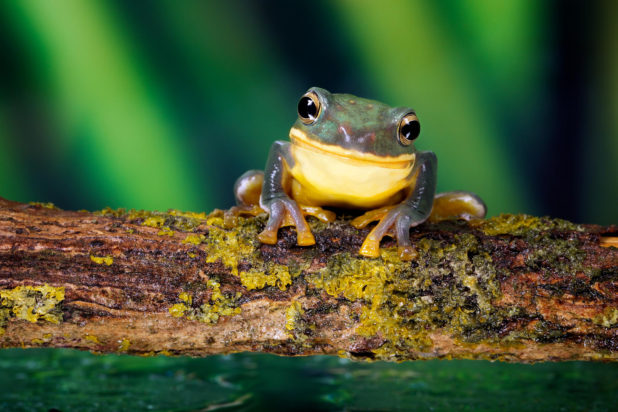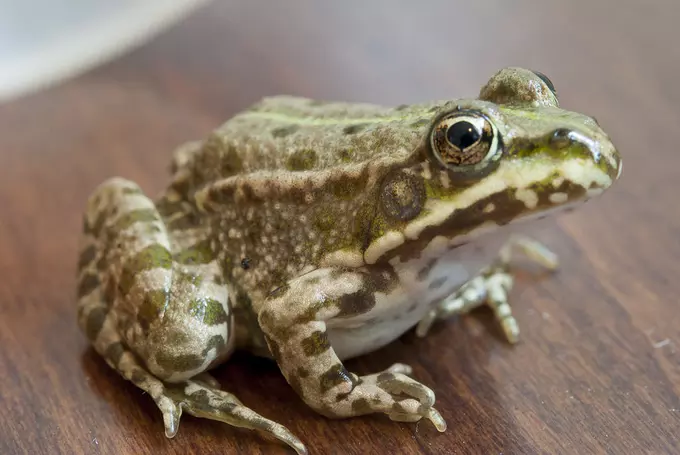The frogs are one of the incredible amphibians that live on our planet. They, despite their own nondescript appearance, are cute and attractive in their own way.
The meat of certain types of frogs in many countries of the world – a favorite delicacy, and everyone knows about eating frog legs in France. In Eastern countries, especially in Japan, Vietnam and China, restaurants have even been opened where these green inhabitants are fed.
Since the advent of the Old Testament, it has been known about the rain of frogs, and throughout the history of mankind, a huge number of such testimonies have been recorded. It looks really fascinating, but at the same time scary. So, for example, in 1912 such rain fell in America. Then about 1000 amphibians covered the ground with a layer of 7 cm. In 1957 and 1968, similar frog rains also fell in England. Scientists have not yet been able to explain this fact.
1. The eyes of frogs have a special structure. This allows them to see up, forward, and sideways. At the same time, frogs can see simultaneously in 3 planes. The peculiarity of this vision of frogs is that they almost never close their eyes. This also happens during sleep.
2. Frogs have a third eyelid. The third eyelid of this amphibian is necessary to keep the eyes moist and to protect them from dust and dirt. The third eyelid of frogs is transparent and is considered a kind of glasses.
3. Frogs manage to pick up all the vibrations in the air, but the most interesting thing is that they hear in the water thanks to the inner ear, and on the ground with their skin and bones due to the audio vibration of the air mass.
4. Being on land, like many other animals, frogs breathe with lungs. In water, they “breathe” oxygen with their whole body.
5. From birth to adulthood, frogs have a tail, but becoming an adult, they shed it.
6. Record holder for the size of his own body among frogs – Goliath. Its dimensions are really impressive, because its body reaches 32 cm in length and weighs more than 3 kg. Due to its massive hind legs, this type of frog jumps a distance of 3 meters.
7. On average, a frog can live from 6 to 8 years, but there have been cases when the life expectancy of such specimens reached 32-40 years.
8. The structure of frog feet varies depending on the habitat of such an amphibian. For example, aquatic varieties of frogs have webbed feet that allow them to swim perfectly in the water. Tree varieties of frogs have specific suction cups on their fingers, which help them to move easily on a tree.
9. In a frog, when moving on land, only one atrium works, while the brain receives oxygen through arterial blood. If such an amphibian moves into the water, then 2 cardiac departments immediately begin to work.
10. Of the 5,000 amphibians that biologists have described, 88% are frogs.
11. Not all frogs can “croak”. The goliath frog is considered dumb, and some other varieties even sing. Some frogs can not only sing, but also grumble, and ring, and grunt.
12. The frog uses its eyes to push food into the esophagus. She does not have the opportunity to perform such actions with the help of the tongue, and therefore the frogs use their eyes, straining some of their muscles. That is why frogs regularly blink when eating.
13. Many frogs that live in the north fall into suspended animation during severe frosts. They begin to produce glucose that does not freeze, and with the onset of spring, amphibians that seemed dead begin to “resurrect”.
14. Tree frog glands secrete hallucinogens that can cause memory impairment, loss of consciousness and hallucinations.
15. Frogs, unlike other representatives of the amphibian class, do not have a neck, but they can tilt their heads.
16. Few people know, but frogs regularly shed their old skin. This happens daily. After the frog sheds its own skin, it eats it to restore the nutrient reserves that are stored in the discarded “clothes”.
17. There is a unique type of frog on the planet. Their offspring are much larger than the parents themselves. Adults of this type can grow up to 6 cm, and their tadpoles reach 25 cm in length, after which they decrease in size as they mature and “grow”. This type of amphibian is called the “amazing frog”.
18. The African hairy frog is actually hairless. The male of this type grows stripes of skin during the mating season. But the most amazing thing is that, being born without claws, they easily make them on themselves on their own. To do this, such frogs simply break their fingers and, thanks to fragments of bones, pierce the skin. After that they become armed.
19. There are dozens of times more males of one of the Amazonian frog species than females, and therefore, at the time of reproduction, they fertilize not only living, but also dead females.
20. A subspecies of the grass frog, in case of danger, burrows into the ground almost 1 meter deep.
21. There is a myth that touching a frog or a toad causes warts, but this is not at all true. The skin of such amphibians has bactericidal properties.

22. Kokoi is considered the most poisonous frog in the world. She has a huge degree of poisonousness, which is more terrible than that of a cobra.
23. Not so long ago, a monument to frogs was erected in Japan. The initiators of this were students of the medical faculty. In the process of training, they had to kill more than 100,000 of these amphibians. By erecting a monument, they decided to honor the memory of amphibians and expressed their gratitude to them.
24. In ancient times, when people did not have a refrigerator, the frog was sent to a jug of milk, so it was not allowed to turn sour.
25. Frogs live both on land and in water. That is why they have a close relationship with the two elements. The Indians from America believed that frogs controlled the rains, and their abundance in Europe was associated with a bountiful harvest.
26. After the frog has been released into the wild, it returns to its former habitat or to the place where it was once caught.
27. In the United States of America, frog competitions have been held every year for a hundred years. They compete in the long jump. This event is quite emotional. Spectators and owners of frogs are actively ill and cheer up amphibians in every way so that they can make a successful high jump.
28. The first work of art that has come down to us, where these amphibians appeared in the title, is Aristophanes’ comedy “The Frogs”. It was first placed in 405 BC. e.
29. In Japan, the frog symbolizes good luck, while in China it is considered a symbol of wealth. That is why many people put a souvenir frog with a coin in its mouth at home or at work.
30. In ancient Egypt, frogs were mummified together with deceased members of the royal family and priests, as they were considered a symbol of resurrection.
